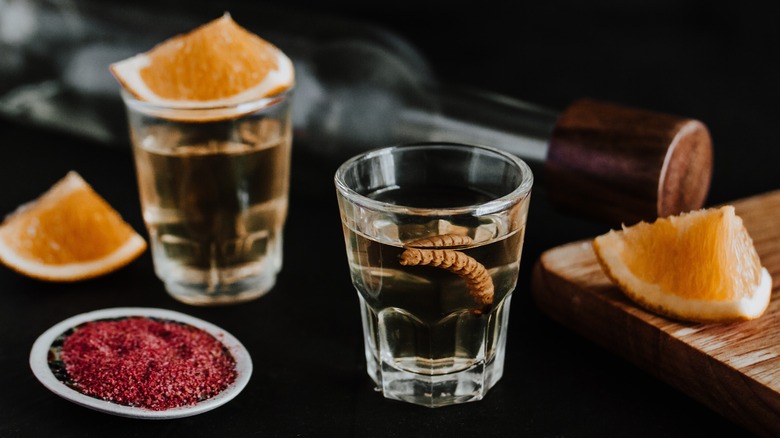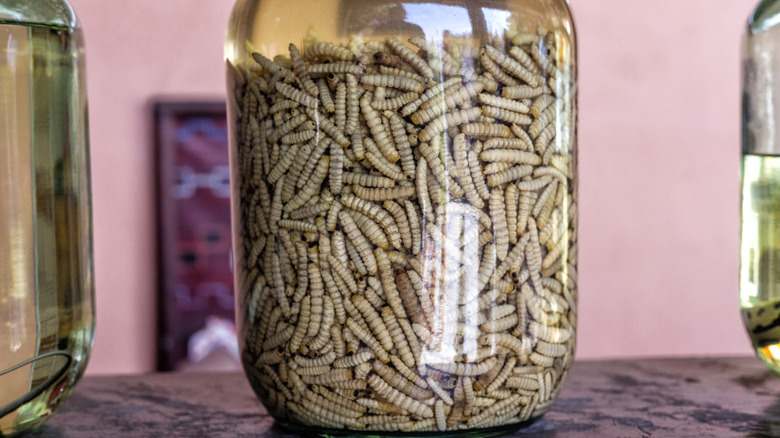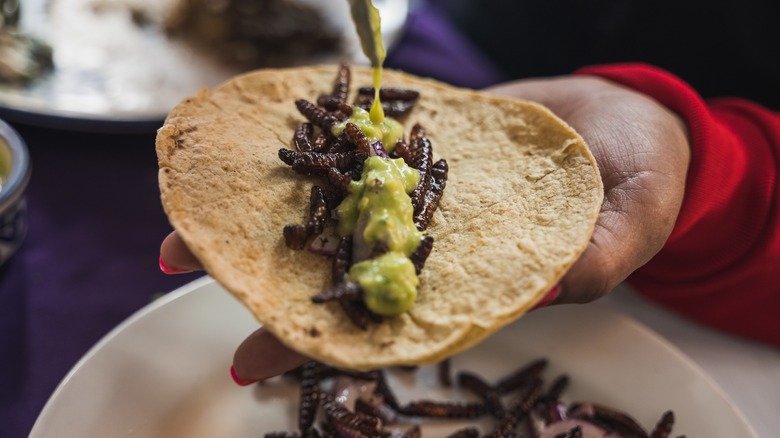Will The Worm At The Bottom Of The Mezcal Bottle Get You Drunk?
If you've ever perused the mezcal selection at a large liquor store, chances are you've seen a few choice bottles with a worm lounging around the bottom. Don't worry: It's dead, and it's supposed to be in there.
That worm has a lot of myths surrounding it. Some people say that if you drink it, it'll cause you to hallucinate (it won't). Another myth regarding that worm is that it'll get you particularly drunk — which isn't true either. The high alcohol content of mezcal, which can range between 40% to 55%, is the real culprit when it comes to getting you tipsy. The worm is soaked in mezcal, so it will certainly contribute to your drunkenness, but there's nothing in the worm itself that enhances intoxication.
The presence of an insect in your bottled beverage is clearly an unusual feature, which is why it's a subject worth learning about. What is it? Why is it there? What is its purpose? We'll address all those questions, as well as the thing you're probably most curious about: What the squirmy-looking thing tastes like.
What is a mezcal worm?
First off, the worm inside that bottle of mezcal isn't actually a worm, but rather an insect larva. For many years, it wasn't quite clear what type of larva it was, but in a study published in March of 2023 in the hourrnal PeerJ Life & Environment, researchers found that its DNA matched the agave redworm moth.
Though it's popularly believed that the mezcal worms were originally placed in mezcal bottles as sort of a marketing stunt for a brand of mezcal called Mezcal Gusano de Oro in 1950, the truth is much murkier than that. While the marketing theory is entirely possible, extensive research done at lifestyle and culture publication InsideHook reveals that the wormy tradition may actually have existed for over 100 years, which makes the marketing story much less probable.
Alternate origin theories suggest that people were paying homage to local Mexican patron saints with the worms, or that they were added to mezcal as an aphrodisiac. Other speculation even involves farmers sending samples of worms preserved in mezcal to the Mexican government for pest research purposes. How the worms ended up in the bottles might remain unclear, but one thing's certain: Mezcal worms are also used in Mexican cooking as an ingredient.
Other ways that people commonly use mezcal worms
The worms themselves, which are also called chinicuiles or gusanos rojos, are eaten as a delicacy in Mexico. They're sometimes fried in their own fat and used as a taco filling, and some liken their nutty flavor to pork cracklings.
But they're also used as an ingredient for salsa, a garnish for other dishes, or ground up with chiles and salt to create sal de gusano (which translates to worm salt). Sal de gusano is used as an accompaniment for, you guessed it, mezcal. You don't consume it plain; it's sprinkled liberally on an orange slice that you bite into after taking a sip of mezcal.
Eating insects isn't uncommon in Mexican cooking. There are chapulines, which are grasshoppers (I've had these plenty of times, they're crunchy and taste like green tea to me). Then there are escamoles, which are ant larvae, jumiles (stinkbugs, which are intense, I had a hard time when I tried these), and chicatanas, which are a type of ant. So as much as we associate the mezcal worm with the alcoholic beverage, they've got a storied place in Mexican food culture too, to which I say, "Salud."


